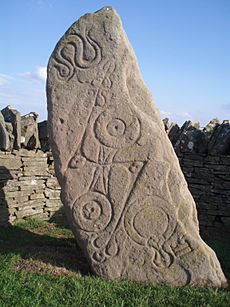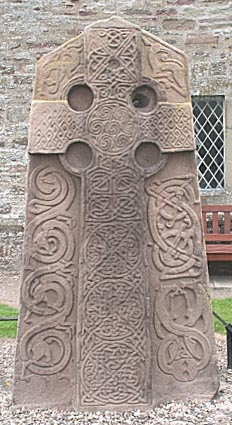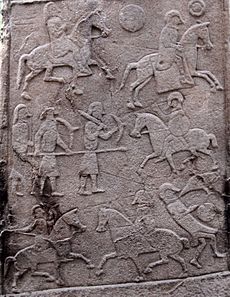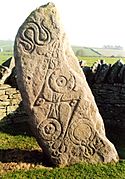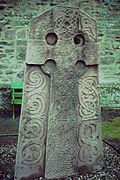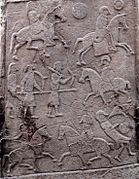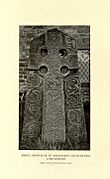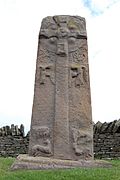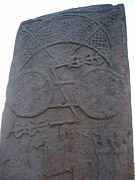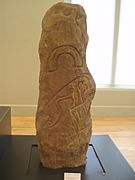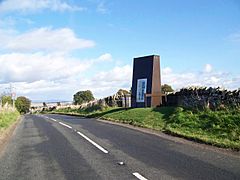Aberlemno Sculptured Stones facts for kids
The Aberlemno Sculptured Stones are a group of five ancient standing stones found near the village of Aberlemno, Angus, Scotland. These stones were carved by the Picts, an ancient people who lived in Scotland during the Early Middle Ages. Some of the stones have only Pictish symbols (Class I), while others have both Pictish and Christian symbols (Class II).
Contents
Where to Find the Stones
Aberlemno 1, 3, and 5 are located along the roadside in Aberlemno. Aberlemno 2 is in the nearby churchyard, about 300 yards south of the roadside stones. To protect these old stones from bad weather, they are covered with wooden boxes every winter. This happens from the end of September until the beginning of April.
Aberlemno 4, also known as the Flemington Farm Stone, was found near the church. It is now on display at the McManus Galleries in Dundee.
About Each Stone
Aberlemno 1: The Serpent Stone
Aberlemno 1 is the central stone of the roadside group. It is a Class I stone, meaning it's a natural stone with symbols carved into its surface. On one side, you can see a serpent, a double disc and Z-rod, and a mirror and comb. The exact meaning of these symbols is still a mystery. The carvings are deep and clear, making this one of the best-preserved Pictish symbol stones. The other side of the stone has older cup marks, showing it was used by people even before the Picts.
Aberlemno 2: The Kirkyard Cross-Slab
Aberlemno 2 is found in the churchyard. It is a Class II stone, which means it is a shaped slab with both Pictish symbols and Christian symbols carved in relief (sticking out from the stone). This stone is made from Old Red Sandstone. It stands about 2.3 meters (7.5 feet) tall.
The front side has a beautiful Celtic Cross. The cross is decorated with different Celtic patterns, including knotwork and keywork designs. Around the cross are animal designs, similar to those found in the famous Book of Kells.
The back side of the stone has two Pictish symbols: a notched rectangle with a Z-rod and a triple disc. Below these symbols are nine figures that seem to show a battle scene. Experts used to think this stone was from the mid-8th century, but now they believe it might be from the mid-9th century.
Aberlemno 3: The Western Roadside Stone
This is another Class II stone found by the roadside. One side has a detailed cross with angels next to it. The other side shows a hunting scene, with two large Pictish symbols above it. This stone is taller and thinner than Aberlemno 2, and it has carvings on all four sides. This suggests it might be newer than Aberlemno 2. Its art style is similar to other sculptures found in northern Scotland, like the Hilton of Cadboll stone.
Aberlemno 4: The Flemington Farm Stone
This stone was discovered in 1961. It is about 1.5 meters (5 feet) tall. It is a Class I stone, meaning it's an unshaped stone with symbols carved into it. It has two symbols: a horseshoe and a Pictish Beast. Part of the beast symbol is a bit damaged from farming, but you can still see it clearly.
Aberlemno 5: The Eastern Roadside Stone
This is a Class I stone located on the eastern side of the road. Its carvings are very worn down and hard to see. Some people think this stone was never finished, or that it might be a later copy.
The Battle Scene on Aberlemno 2
On the back of Aberlemno 2, there's a scene showing people with weapons, looking like they are fighting. The figures are arranged in three rows.
- The top row shows a rider without a helmet chasing a helmeted rider. The helmeted rider seems to have dropped his sword and shield.
- The middle row has a helmeted rider facing three foot soldiers without helmets. All are armed with spears, swords, and shields.
- The bottom row shows two mounted figures facing each other, both with spears. Behind one of the helmeted riders, there's a fallen soldier with a bird nearby.
People have thought about this battle scene in many ways. For a long time, it was believed to show the Battle of Barry. However, later research showed that battle was not real.
More recently, some historians believe the scene might show the Battle of Dun Nechtain. This important battle happened in 685 AD, where the Picts defeated the Northumbrians (an Anglo-Saxon kingdom). The helmets on the stone look a bit like Anglo-Saxon helmets, which led to this idea. The stone is also quite close to Dunnichen, a possible site for the battle.
However, the exact meaning is still debated. Some experts now think the stone was carved later, around the mid-9th century. This would mean it might show a battle between Picts and Vikings, or perhaps it's a memorial to a Pictish king named Óengus I. It could even represent a spiritual struggle rather than a real battle.
Gallery
See also
 In Spanish: Piedras esculpidas de Aberlemno para niños
In Spanish: Piedras esculpidas de Aberlemno para niños


